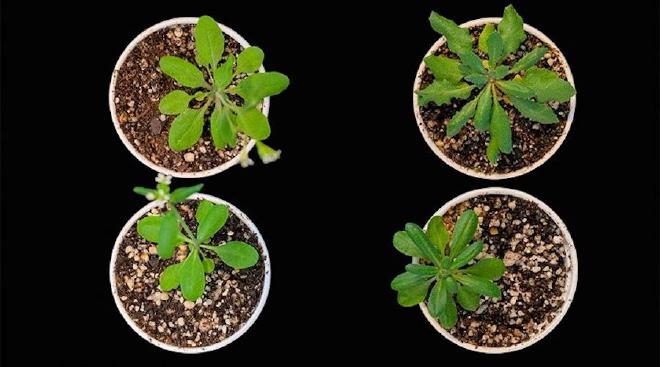

Present in all living organisms, from yeast to humans, the PRMT5 protein plays an essential role in regulating various cellular processes, including splicing, the mechanism by which a single gene is capable of producing multiple proteins. Now, a study led by researchers from CONICET, the Leloir Institute Foundation (FIL), and the University of Buenos Aires (UBA), published in the journal New Phytologist, has revealed a new function of PRMT5: it is also responsible for “buffering” the effects of small genetic variations that constantly occur inside the nucleus of cells, allowing a species to retain certain basic characteristics.
“We found a mechanism in plants that attenuates the impact of genetic differences; if the PRMT5 protein is absent, these disparities are maximized, even in individuals belonging to the same species,” explained Marcelo Yanovsky, co-director of the work and a CONICET researcher at the Buenos Aires Institute of Biochemical Research (IIBBA, CONICET-FIL) and at FIL. “The discovery could also have an important impact on humans, since PRMT5 is known to be involved in many types of cancer,” he added.

Currently, in fact -stated and article on CONICET’s website-, much of the research being conducted in the field of oncology revolves around how to inhibit the presence of PRMT5 when it’s elevated. “The issue is that these therapies won’t have the same effect on one person as on another. So, understanding this new function of the protein could help identify who will or won’t benefit from a potential treatment,” Yanovsky highlighted, also head of the Comparative Genomics of Plant Development Laboratory at the International Plant Development Institute (FIL). He added that “in plants, on the other hand, inhibiting PRMT5 could allow us to discover new phenotypes (varieties with specific physical characteristics) that are currently masked, to take advantage of them under certain environmental conditions, such as low temperatures or lack of water.”
Winding road #
In 1993, scientists Phillip Sharp and Richard J. Roberts shared the Nobel Prize in Medicine for breaking with the established dogma that a gene always gives rise to a single protein. They demonstrated that, thanks to a complex process called RNA splicing, a single gene can produce multiple different proteins. This revolutionary discovery allowed to better understand the enormous genetic variability that exists in nature, which is fundamental to the evolution and diversity of species. It also helped to understand the roots of diseases such as cancer and certain neurological disorders.
To better understand the contribution of the published study, it is important to remember that all cells contain an instruction manual—the genome—that enables the development of a living organism. Written in the language of DNA, it contains the recipes (genes) for making all the proteins necessary for life. However, when a cell needs a specific protein, it does not directly consult the original manual, but rather transcribes a working copy of the recipe: a precursor messenger RNA molecule, or pre-mRNA.
That first copy isn’t a literal transcription. It’s more of a heavily annotated draft, with crucial sections (the exons) interspersed with segments that, for the most part, need to be removed (the introns). And this is where the aforementioned process discovered by Sharp and Roberts— splicing —comes into play. It occurs thanks to sophisticated molecular machinery known as the spliceosome, a kind of precision molecular editor whose job is to meticulously cut out introns and join exons together in the correct order. The result? A mature messenger RNA (mRNA) molecule, ready to be translated into a functional protein.
This editing process is a source of immense biological diversity, as the spliceosome can combine the exons of the same gene in different ways. Thanks to this, a single gene can give rise to a variety of different proteins, each with specialized functions. At the center of this intricate molecular ballet, the PRMT5 protein acts as an orchestra conductor or quality control manager for the splicing process.
“This ability of an organism to produce a consistent phenotype despite genetic or environmental variations is known as canalization. Our study showed that, by ensuring the spliceosome can handle ‘imperfect’ or weaker splice sites, PRMT5 acts as a ‘buffer’ and allows life to tolerate a certain degree of genetic noise without immediate negative consequences,” explained Ariel Chernomoretz, co-author of the work, a CONICET researcher at the Institute of Interdisciplinary and Applied Physics (INFINA, CONICET-UBA), in the Physics Department of the Faculty of Exact and Natural Sciences at the University of Buenos Aires (UBA), and head of the Integrative Systems Biology Laboratory at FIL.
Experimental design #
For the experiment, the researchers selected two genetically distinct strains of Arabidopsis thaliana, often referred to as the “lab rat” of the plant world: Columbia (Col-0) and Landsberg erecta (Ler). Although both belong to the same species, they followed separate evolutionary paths and accumulate small natural differences (SNPs) in their genetic code. Some of these differences are found in the so-called splice sites for the spliceosome.

With Maximiliano Beckel and Abril San Martín as first authors, the article describes how the group introduced a “switch” to turn off PRMT5 activity: using CRISPR-Cas9, a novel gene-editing tool, the scientists created plants from both strains (Col-0 and Ler) that lacked the protein in question. This allowed them to compare four groups of plants: normal Col-0, Col-0 without PRMT5, normal Ler, and Ler without PRMT5.
“The results were surprising and revealing,” emphasized Yanovsky. “Despite their underlying genetic differences, under normal conditions, with PRMT5 active, the Col-0 and Ler strain plants had almost indistinguishable physical characteristics (phenotype), such as leaf shape or flowering time.” However, the picture changed dramatically when PRMT5 was eliminated. “In its absence, latent genetic differences were unleashed, resulting in much more pronounced phenotypic differences: the leaves of the Col-0 plants became serrated, a trait not visible in the Ler plants, and the differences in flowering time between the two strains were significantly exaggerated,” he explained.
With this result in hand, one of the challenges ahead is to test the effect of PRMT5 deficiency in humans. “If the same thing happens as in plants, it could have potential implications for many of the cancer therapies currently being tested based on inhibiting PRMT5 function,” Yanovsky concluded.
Citation #
-
The paper Arabidopsis PRMT5 buffers pre-mRNA splicing and development against genetic variation in donor splice sites was published on New Phytologist journal. Authors: Maximiliano S. Beckel, Abril San Martín, Sabrina E. Sánchez, Danelle K. Seymour, María José de Leone, Daniel A. Careno, Santiago Mora-García, Detlef Weigel, Marcelo J. Yanovsky & Ariel Chernomoretz.
-
The article Revelan nueva función de una proteína que podría ser útil para aplicaciones en agricultura y oncología was published in CONICET’s website based on an article from FIL.
Contact [Notaspampeanas](mailto: notaspampeanas@gmail.com)

